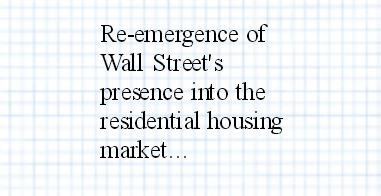Bubble Bubble Froth and Trouble
Thu Feb 6, 2014 by Oppenheim Law on Florida Law News
Written by Roy Oppenheim for the South Florida Law Blog.
![]() As 2014 continues to move along, one disturbing trend on the horizon is the re-emergence of Wall Street’s presence into the residential housing market. This time however it’s a horse of a different color and it could mean trouble.
As 2014 continues to move along, one disturbing trend on the horizon is the re-emergence of Wall Street’s presence into the residential housing market. This time however it’s a horse of a different color and it could mean trouble.
During the last economic cycle, Wall Street provided easy money to anyone with a pulse, then bundled up these mortgages, and called the sacks of garbage Grade A securities as they were sold off to unsuspecting investors around the world as well as here at home.
Now eight years later we are seeing a variation on an old theme amid froth and bubble. This time instead of serving the investors with a monthly stream of income based on purported mortgage payments, Wall Street is providing investors with a security backed by the rental income of single-family homes.
A New Real Estate Bubble
Some fear turmoil and trouble with justification that we may be inflating a new real estate bubble. While sales and prices of homes have jumped in the past few years, Wall Street has set in stone a new plan. Investment bankers are chomping at the bit to finance investors anywhere from large, private equity firms to mom-and-pop landlords, who are purchasing foreclosed homes, fixing them up, and renting them out.
Wall Street has estimated the potential financing opportunities in real estate for this rental industry as high as $1.5 trillion, even in its beginning stages. Even a few members of Congress are apprehensive of the possibility of facing another credit bubble.
Over the last two years, around 200,000 single-family homes were purchased by large investors and are now being rented out. Private equity giants attracted a multitude of investors with a $479 million bond by selling the first single-family rental securitization last year. Mutual funds and insurance companies purchased smaller pieces of the bond, which are secured by rent flowing from the purchased homes. Even with numerous investors flooding the market, the rental business still consists primarily of mom-and-pop landlords who own and manage a small number of rental units. Taking that into consideration, private equity giants like Blackstone Group and Cerberus Capital Management have started companies that lend to small and medium-sized investors to provide cheap financing.
 Securitization of Rents
Securitization of Rents
People who want to buy a home may find themselves outbid by investors with deep pockets. Without proper mechanisms to oversee this new securitization of rents, we will likely head down a similar, troubling path.
Securitization could provide resurgence to Wall Street’s mortgage machine, helping to recover from the past financial crisis. Single-family rental bonds are estimated to total as much as $7 billion this year with the potential of growing to about $20 billion a year. This does not come without concern. Securitization will allow landlords to invest as little as 25 percent equity into their properties, taking on loans to cover the rest. This is a drastic difference from the typical 40 percent equity banks require for investment properties.
On one hand, securitizing debt can offer landlords leverage to buy even more home. However, if those larger landlords take on more debt than they can handle, there is a possibility they may feel pressured to flood the housing market by selling off all of their properties.
“With the country’s financial stability already on shaky ground, market concerns may become more prevalent should debt financing significantly increase, or if investor owned homes significantly increases in certain housing markets.”
Furthermore, the development of single-family rental securitization could threaten market stability. For now, there is plenty of profit to be made but there is no telling if rental securitization is forming a new market bubble to create new froth in troubled waters.
From Wall Street to Main Street, Roy Oppenheim is a Florida real estate attorney focusing on foreclosure defense and loss mitigation.
He is a guest legal blogger for Yahoo! Homes and comments regularly on real estate law and policy in the national media. Oppenheim Law reports the highest rating (A-V) conferred by Martindale Hubbell Law Directory, the most respected directory of lawyers and law firms in the U.S. He is also the creator of the South Florida Law Blog,named the best business and technology blog by the South Florida Sun-Sentinel. Follow Roy on Twitter at @OpLaw or like Oppenheim Law on Facebook.



Great article. I would say that securitization of rents is forming a market bubble for sure.
Now, to address the increase of privacy and information
fifa 14
Bubble Bubble Froth and Trouble | South Florida Law Blog